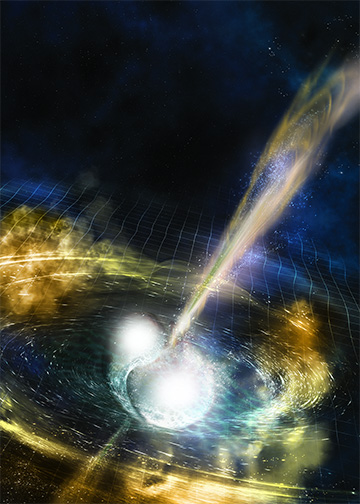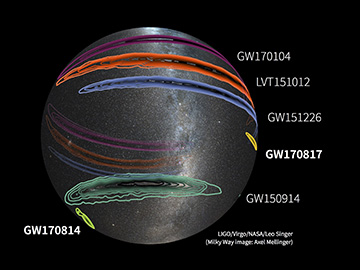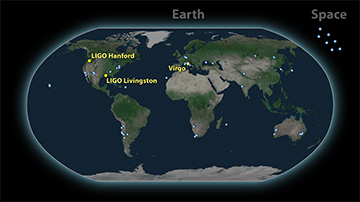An artist’s rendering of two merging neutron stars, with gravitational waves shown as a rippled grid in spacetime, and narrow beams depicting short gamma-ray bursts. [Image: NSF/LIGO/Sonoma State University/A. Simonnet] [Enlarge imge]
Around 130 million years ago—even as dinosaurs were stomping their way across planet Earth—a distant pair of incredibly dense neutron stars rapidly spiraled toward one another, finally merging in a massive collision. The cataclysm, and the run-up to it, announced itself to the universe in multiple ways: a long rumble of gravitational waves; a brilliant gamma-ray burst; and other subsequent energy emissions across the electromagnetic (EM) spectrum, from radio waves to visible light to X-rays. Those cosmic messengers, traveling at the speed of light, set off from the event in the moments, days, and weeks that followed.
Almost exactly two months ago, the messengers finally reached Earth.
In a remarkable finding combining measurements from three gravitational-wave observing facilities with those a constellation of other telescopes monitoring EM radiation across the sky, scientists have put together a synoptic, detailed picture of one of the universe’s more exotic and long-sought events: The collision of two neutron stars. The early analysis of data from the event, certain to be studied intensively for years to come, has already resolved nagging questions on the ultimate origin of some of the periodic table’s heavier elements, as well as settling controversies on the dynamics of these high-energy collisions—heretofore only the stuff of theory.
Optics and photonics triumphant
The finding—officially announced at coordinated press conferences Monday, 16 October, at the National Press Club in Washington, D.C., and elsewhere—had been rumored since the middle of August. And it marks the first time, according to the executive director of the Advanced Laser Interferometer Gravitational-wave Observatory (LIGO), OSA Fellow David Reitze of the California Institute of Technology (Caltech), that such a cataclysmic astrophysical event has been detected in both conventional electromagnetic observations and the “chirp” of gravitational waves.
“We’ve moved from the era of silent to ‘talking’ movies” of the cosmos, Reitze said. Another speaker at the press event, Laura Cadonati of the Georgia Institute of Technology, USA, put a slightly different multimedia spin on the finding. “We’ve gone from the equivalent of looking at a black-and-white picture of a volcano,” she suggested, “to a 3-D Imax movie of Vesuvius.”
The finding thus finally puts some flesh and bones on the long-promised vision of a new “multi-messenger astronomy” that gravitational-wave observatories would initiate. Yet, in a larger sense, it can also be seen as the culmination of centuries of progress in optical and photonic technology. That technology underlies virtually every part of the Monday announcement—from the sensitive optical elements, CCDs and other components that combine in today’s Earth- and space-based telescopes, to the sophisticated signal-processing techniques of radio astronomy, to the incredibly precise lasers and ultra-sensitive detectors that made the Nobel Prize–winning accomplishments of LIGO and Virgo possible in the first place.
Multinational sky search
The lead players in this particular cosmic movie were two neutron stars, of roughly 1.1 and 1.6 solar masses respectively. These objects, which result from the collapse of the remnants of supernovae, are phenomena that seem to invite superlatives. They are the smallest and densest stars known—around 20 km across, with the mass density greater than that of atomic nuclei. A teaspoon of matter scooped from a neutron star would weigh in at roughly a billion tons. And neutron stars can spin at rates of hundreds of times a second, giving rise to the radio signals of pulsars.
Yet almost as dramatic as the collision of two of these massive, exotic objects is the story of how the energy from that collision was detected and analyzed on Earth. That story began with a long pealing of gravitational radiation picked up by the LIGO detector in Hanford, Washington, on the morning of 17 August, at 5:41 a.m. Pacific Daylight Time. (The timing seems almost providential; the date was only a few days before the LIGO facility was slated to end its observing run and go into maintenance for a year.)
Sky localizations of the gravitational-wave signals detected thus far. The most recent detections, by the LIGO-Virgo network (GW170814, GW170817), show the improvement in localization after Virgo came online in August 2017. [Image: LIGO/Virgo/NASA/Leo Singer (Milky Way image: Axel Mellinger)] [Enlarge imge]
In striking contrast to previously reported, sub-second-duration gravitational-wave signals, all of which have been attributed to black-hole collisions, the 17 August event—dubbed GW170817—stretched out over more than a minute and a half and covered the full acoustic frequency range sampled by LIGO. That, based on previous modeling, tipped LIGO scientists off that the signal likely came from a neutron-star collision.
Around two seconds after the detection at Hanford, the NASA Fermi space telescope’s Gamma Ray Burst monitor—constructed of a set of sodium-iodide and bismuth-germanate scintillation detectors sensitive to energies between 8 keV and 40 MeV—picked up a short gamma-ray burst, confirmed soon afterward by a second spaceborne gamma-ray observatory, the INTEGRAL platform of the European Agency (ESA). That detection, which seemed unlikely to be a coincidence, pushed the gravitational-wave community into high gear. To confirm the signal from Hanford, the LIGO scientists quickly teased a second signal from its sister facility at Livingston, Louisiana. And a third, faint confirming signal from the Advanced Virgo gravitational-wave observatory in Italy, which had come on line only weeks before, soon followed.
Finding the source
The three signals together allowed the LIGO-Virgo team to triangulate the source of the gravitational-wave emission to a relatively small patch in the southern sky. Jo van den Brand of VU University Amsterdam, the spokesperson for the Virgo collaboration, described it as “the most precise sky localization of all detected gravitational waves so far.” In part that was, ironically, because the Virgo signal was so weak; that weakness, in turn, told scientists that the source probably lay near one of Virgo’s “blind spots,” allowing a probable location to be pinned down with extra precision.
With the event’s location pinned down, the next step was an all-points bulletin to a worldwide network of astronomers working various parts of the ER spectrum, urging them to point their telescopes to that patch of sky to follow up on LIGO’s observations. Within hours, the Swope optical telescopes of the Carnegie Institution’s Las Campanas observatory in Chile had found a new point of visible light in the galaxy NGC 4993, within the constellation Hydra, and squarely in the zone in which LIGO-Virgo and Fermi had detected the high-energy event. And in the weeks that followed, some 70 observatories on the ground and in space gathered in EM data from the event at a wide range of wavelengths.
Solving a heavy-element quandary
The LIGO-Virgo detection kicked off a worldwide sky search that ultimately pressed into service approximately 70 light-based observatories worldwide and in space. [Image: LIGO-Virgo] [Enlarge imge]
While those facilities will continue to study GW170817’s patch of sky for months to come, the event has already borne considerable scientific fruit. One part of the harvest has been a confirmation about the origin of short gamma-ray bursts like the one detected along with the gravitational waves. “For decades,” said Julie McEnery of NASA’s Goddard Space Flight Center in Greenbelt, Md., USA, “we’ve suspected that short gamma-ray bursts were powered by neutron star mergers.” The data from LIGO-Virgo, which were consistent with such a merger, provided the first opportunity to add some observational weight to that hypothesis, and to tie a short gamma-ray burst directly to a neutron-star collision.
The follow-up studies of GW170817 have also helped settle a long-standing debate regarding the origin of about half of the elements heavier than iron on the periodic table. It’s been known for many years that these elements—which include some uniquely valuable materials such as gold, platinum and neodymium—are likely synthesized by an neutron-capture process known as r-process nucleosynthesis.
But there’s been debate about just where this process happens. While it’s long been assumed that most of it takes place during explosions of core-collapse supernovae, that mechanism isn’t efficient enough to generate the abundances of heavy elements seen in the universe. Astronomers have thus increasingly suspected that neutron-star collisions may instead constitute the main furnace that forges these heavy elements.
Infrared radiation from the GW170817 event—first picked up by the Gemini South telescope in Chile, and supplemented by additional observations by other ground-based facilities—resulted in spectra that confirmed that this neutron star merger, at least, did indeed churn out vast quantities of heavy elements. Edo Berger of Harvard University noted that the spectrographic and other observational data suggest this single event created some 16,000 Earth masses worth of heavy elements—10,000 Earth masses of gold and platinum alone.
The observations of GW170817 also yielded up additional information—confirming, for example, that gravitational waves do indeed move at the speed of light, as Einstein predicted. The delay of the radio and X-ray signals from the event was perfectly timed to buttress arguments for the long-hypothesized presence of off-axis high-energy jets from these spinning objects. And the ability to spot gravitational waves offers another “standard candle”—or more precisely, as Cadonati said, a “standard siren”—for determining vast distances in space and thus constraining changes in the Hubble constant, a potential boon to cosmology.
“What’s amazing,” noted Vicky Kalogera of Northwestern University, a member of the LIGO Scientific Collaboration, “is that in one day, and then in the week that followed, all of these predictions were confirmed.”
Next steps, new targets
As always, the new finding has whetted scientists appetite for more data and discoveries. Toward that end, LIGO and Virgo will be taking a year offline to double instrument sensitivities—a maintenance stop that, observed LIGO spokesperson David Shoemaker, will increase the volume of space visible to the observatories by a factor of eight.
Asked during the press conference about what other kinds of targets the upgraded LIGO might see, Reitze noted that the team would “love to see” a supernova explosion, though those aren’t a safe a bet as neutron star and black-hole collisions. But van den Brand also pointed out that amassing additional observations of the kind that the LIGO-Virgo consortium has already assembled is valuable in itself, as they will allow scientists to further nail down the Hubble constant and make new inroads in cosmology.
And, of course, all parties hope that combining the observations of LIGO, Virgo, and future gravitational-wave observatories with those of traditional EM astronomy will lead to other, entirely new discoveries. “Gravitational waves and light at all wavelengths have given us an amazing multisensory learning experience in the study of the universe,” said Alessandra Corsi, a radio astronomer from Texas Tech University, USA, in wrapping up the press conference. “Welcome to the era of multi-messenger astronomy.”



